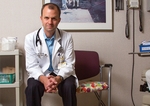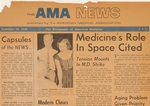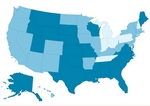business
Online contact growing between physicians, patients
■ A practical look at information technology issues and usage
By Pamela Lewis Dolan — covered health information technology issues and social media topics affecting physicians. Connect with the columnist: @Plewisdolan — Posted Feb. 15, 2010.
- WITH THIS STORY:
- » Who's using e-mail
- » Related content
Girish Munavalli, MD, assistant professor of dermatology at Johns Hopkins University School of Medicine, never considered dermatologists to be all that tech-savvy.
But many of his colleagues -- more than any other specialists -- are communicating with patients online. They're doing so for the same reasons that Dr. Munavalli has been interacting online with patients for several years: It's a quick and easy way for physicians in a busy practice to make themselves available.
Manhattan Research's recently released report, "Physicians in 2012: The Outlook on Health Information Technology," found that 39% of physicians use e-mail, secure messaging or instant messaging to communicate with patients, up 14% from 2006. Dermatologists were the most likely users, followed by oncologists, neurologists, endocrinologists and infectious disease specialists. Primary care physicians ranked sixth on the list.
The overall growth of online communication can be attributed to an increased comfort level for both physicians and patients, according to Erika S. Fishman, director of research at Manhattan Research.
"Answering clinical questions is one of the most popular activities conducted by physicians communicating with patients online, but other tasks include discussing symptoms [and] treatment options and determining whether an office visit is necessary," Fishman said.
While the study found that physicians from certain specialties are most likely to communicate online with patients, Fishman said patient load is generally a greater determinant of how a physician integrates technology into the workday.
"Dermatologists probably have some of the highest patient volumes of any medical specialty," Dr. Munavalli said, "and with that comes a lot of triage calls and calls for clarification of instructions. This is perfect for short e-mail communication and reminders."
Manhattan Research would not release the actual percentage of physicians from each specialty who use online communication. But the American Academy of Family Physicians found that 30% of respondents to their 2009 Practice Profile survey communicated with patients via e-mail, up from 21% in 2008.
Online communication could be an indicator for how well physicians embrace other technologies, Fishman said.
"As we work to remove the barriers to physician adoption of online communication with patients, and each party becomes more comfortable with exchanging health information online, we could see a parallel movement in use of electronic medical records and personal health records," she said.
Daniel Hoch, MD, PhD, a neurologist at Massachusetts General Hospital in Boston, said he has been pushing colleagues to expand their online patient communications for more than 15 years. Despite the resistance he has felt at his own hospital, the survey's finding that neurologists were top users made sense, he said.
Neurology patients with limited mobility sometimes have problems making the trip to the doctor's office, according to Dr. Hoch. He used to rely heavily on telephone communications, but many of those conversations now take place online.
Many of the specialties topping the list are likely responding to pressure from patients, Dr. Hoch said. Two patient populations in particular -- those with cancer and those with neurological diseases -- were among the first to create online communities. "Because they started doing it early on, it just grew from there."
Fishman said the number of patients interested in communicating online with their doctors far outweighs the number of those actually doing it. She sees the slow growth among some specialties as "more of a supply and marketing issue than a demand concern."
"Physicians who've refrained from e-mailing their patients cite fear of liability and doubts about benefits to practice efficiency as barriers," she said. But "the option to receive consultations and referrals from a home computer can be an especially useful customer-service offering for patients who are busy juggling children or who aren't mobile enough to easily get to the doctor's office."
Pamela Lewis Dolan covered health information technology issues and social media topics affecting physicians. Connect with the columnist: @Plewisdolan —












